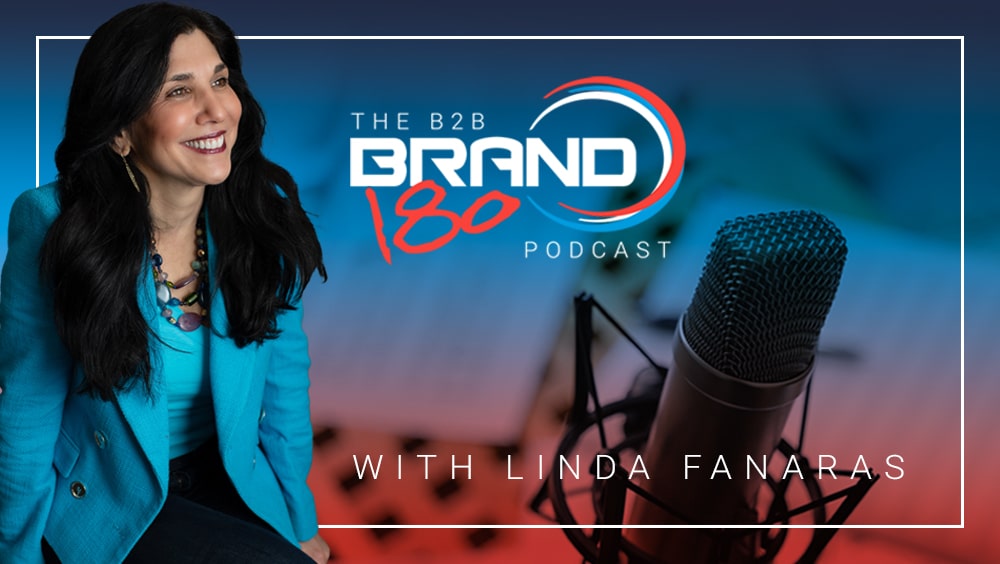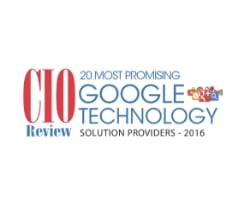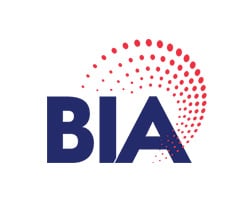In this episode of B2B Brand180, Linda welcomes Ian Baer, founder of Sooth, to explore the impact of emotional engagement in B2B marketing.
Ian brings a wealth of experience from his leadership roles across various major brands and discusses how tapping into emotional drivers can significantly enhance brand strategies. The discussion also explores the shifting landscape of the B2B sales journey, emphasizing its departure from traditional linear models to more complex, customer-centric approaches. Tune in to learn more about the interconnectedness of branding, marketing, and sales in the B2B sector.
More about Ian Baer: https://www.linkedin.com/in/ianbaer and Sooth https://www.soothbetold.com/
You can follow Linda at: https://www.linkedin.com/in/lindafanaras/
and visit Millennium Agency at https://www.linkedin.com/company/millagency/
Linda Fanaras:
Hi, I’m Linda Fanaras, host of B2B Brand 180 Podcast and CEO of Millennium Agency. And today it’s where we’re going to talk all about branding and growth strategies and ways to help your business grow. But before I get started, I just want to take a minute to thank our audience for listening. And if you like what you hear today, please like, share, or subscribe. So today I am very excited to bring in Ian Baer. He’s the founder of Soothe. He’s has spent his career helping major brands in leadership roles, including publicist, TBWA, rap and many others. And he’ll touch on this shortly after. He, his experience spans from almost every business and consumer marketing category. Working with Verizon, Samsung, American Express, Adobe, JP Morgan, Chase, and others. So, welcome Ian, and thanks for coming to the B2B Brand 180 podcast today.
Ian Baer:
Thank you, Linda. Thanks for having me. I’m excited. it’s great to have you. Gosh, you just went through a laundry list of some of my all time favorite clients there. So that’s
Linda Fanaras:
awesome. Well, let’s get started with a quick introduction about you. I’ll turn it over to you. Tell us a little bit about yourself that I maybe didn’t cover yet. And we’ll get started with some questions to help our audience today. Sounds
Ian Baer:
good. Well, I like to say that I did every job you can do in the agency world. I spent 35 years. Working for some of the biggest agencies in the world. I was president of three agencies. I was chief strategy officer, three agencies. I had a seven year run as a chief creative officer. So I, wore all those hats and when I ran out of things to do in the agency world, I pivoted out about two years ago to start sooth, which is a marketing insights platform and consultancy. That’s focused on helping brands connect with the emotional needs of people who buy from them, both business and consumer.
Linda Fanaras:
That’s awesome. Because we definitely need that emotional connection these days. And I have to give you, I have to give you kudos if you’ve been working in the ad space for all those years, you must have some serious stamina.
Ian Baer:
Well, you know what? I love the business. I always say I feel bad for people who don’t love what they do. I’ve had the good fortune now for decades to be able to do something I really enjoy to, to build my craft. And really in a lot of ways, you know, the company that I started is just codifying. The unique way I’ve had of doing things all along. So it’s, this is still a labor of love, despite the fact that. Yeah. It also keeps the lights on. Yeah.
Linda Fanaras:
so why exactly did you leave the agency space to start your own company? Was there something that sort of jolted you into a new direction?
Ian Baer:
I read an article, I think those of us who, who try to stay well informed and maybe a little ahead of the game in the industry, every now and then you read something that really makes you step back and changes your perspective. And in, I think it was 2016, I read an article in the Harvard business review. That was called the new science of customer emotion. And for a long time, I had preached the value of emotional connection to the clients I’ve worked with, but it was always this battle of, well, that sounds like a warm, fuzzy thing. But, you know, I’m all about results and this was the first time there was a really well developed white paper that showed the ROI potential behind emotional connection. And as time went on and the work I was doing with clients, that became my obsession to help clients find a unique connection to their customers purely on the basis of their emotional motivation. And eventually I actually developed that into a scalable, repeatable scientific method. We have a patent pending now, and that’s one of the reasons I started Sooth is everything is now driven off this platform of being able to predict the emotional needs of customers based on Data that’s readily available in the market.
Linda Fanaras:
That’s great because I think what happens with a lot of corporations is that they’re focused on their product, you know, they’re focused on their company and they’re talking about their, their feature, their features and even their benefits and. Their benefits do not line up with that necessarily that emotional connection that we talk about. And I like to look at the example of FedEx, because I think when they first launched, they did a great job with their positioning on, on making that saying, Hey, you know, overnight delivery guaranteed. I mean, that immediately, I mean, the minute you hear those few words, you have an emotional connection with that brand and that you know, you’re going to get this guarantee and they’re going to make that delivery. So. to talk about that connection, to talk about that sort of way to be able to get to that place. Can you tell us a little bit, how do you get to that place with your platform?
Ian Baer:
Well, so again, going back to that Harvard study that, that did change my perspective, they found that out of the 34, 000 different emotions that we feel, I mean, gosh, human beings are just incredibly complex. There are only 10 that have ever proven to positively correlate to purchase behavior. And when you consider that 90 percent of all the choices we make as human beings are emotional, if you can help a brand understand not only which of those emotions come most into play for their customers, but what the hierarchy is. Then you really start to unlock something because these emotions are things like the desire to have fun, the desire to have freedom, the desire to feel like you’re connected to a community, the desire to feel safe, and we all feel all those things. But understanding when you’re coming down to a decision where you’re choosing between the thing that looks like a good time and the thing that feels safe, being able to predict which of those you’re going to choose. Consistently. Right. That is really going to unlock a lot of success for a brand. That is what we’re able to do. We actually have a method that takes those 10 emotional elements and we produce something that looks and operates a lot like a credit score for each of those. Okay. So if I know that you’re a 742 for confidence and a 356 for fun, I know how to speak to you. I know that finding ways to inspire your confidence Is going to be more appealing than, showing you what might look like it’s going to be a blast, but might not make you feel any better about what you’re doing at work every day.
Linda Fanaras:
So I’m, I’m also curious as far as your product is concerned, what do you think makes that so unique compared to some of the other, platforms that are out there or even processes that are out there by companies?
Ian Baer:
Well, there’s certainly a lot of processes at play and look, some of these things, traditional market research has been doing for years. Here’s the difference. Everything I do starts with data on everything we do starts by looking at 220 million U. S. adults and we’re able to cross reference. Thousands of different, not only demographics, but more importantly, behavioral elements, psychographics, transaction behaviors, attitudes, tendencies. And by using AI, we can crunch all of that data in days or weeks. compared to what used to take maybe three to six months worth of market research and maybe, you know, an investment of a couple of 100, 000 to get to the sort of data we can produce for clients and allow them to act on in a few weeks time. So it’s that speed to market the ability to generate the insights. before they expire. Because things do right quickly, but also the 95 percent confidence level that you get from having these massive sample sizes that we can not only query once, but we can actually maintain them as a panel and keep going back to them. Every time the brand has another question about how might this offer play or how do they look at this competitor in the market or How has let’s say the current election cycle impacted the way people are writing in my category? We can hone in on those things immediately.
Linda Fanaras:
So you can get immediate results.
Ian Baer:
Yes, it’s Basically, we’ve done what traditional quantitative and qualitative Research can deliver in a fraction of the time fraction of the cost with a much higher level of statistical accuracy because All of our results are, as I said, at a 95 percent confidence level because of the massive amounts of data that
Linda Fanaras:
we. Do you think that this is a product that’s great for agencies, corporations, marketing, departments, who would this be ideal for both?
Ian Baer:
We’ve applied it so many different ways. You know, the funny thing is when you start a company. That essentially is doing the sort of work that hasn’t been done before. You have some perceptions from day one at the beginning. I said, well, I think we’ll probably be a great secret ingredient for agencies and pitches. I think we’ll help brands looking for an edge maybe in positioning. But what we have found is in one example, we worked with a pharmaceutical company to help them identify the emotional needs. of a base of suffers of a disease that most people don’t even know they have. So because this population is not diagnosed, not identified, there is no third party data available. It’s hard to even recruit a research panel, but we could look at things like symptom profiles, how much people have visited certain types of specialists, and actually convene a panel of sufferers. Who haven’t even been diagnosed for one of our clients in the tech space, we were able to help them identify an entirely new B to B business model to reposition their technology solutions in a, in a different way, differentiate them from much larger players in the market. So, so we’ve done everything from brand positioning work all the way down to like very precise. Social media strategies that that map to not only what the audience you want to reach is doing in social, but platform by platform exactly which activities they’re performing there. So we could map it. Almost like a playbook and say, here’s exactly how to spend your money to have outsized impact with your target.
Linda Fanaras:
you know, over the years, have you actually seen the lines between the B2C market and the B2B market blur, or do you still see them as being separated? How do you?
Ian Baer:
How do you view that? I think they blurred dramatically. You know, I, I think the Amazon effect Mm-Hmm. five years ago, we were still mostly talking about how consumer brands were gonna keep up with that, right? But what has happened, and especially the impact of the pandemic where suddenly. People are, they’re sitting in the same chair in the same room and, and seamlessly shifting from I’m a CFO, now I’m a dad, now I’m a, you know, a car enthusiast and, and, and there’s no compartmentalization of life anymore. So, people increasingly have had the same expectations for everything. to work like Amazon for everything to work as easily as, as their mobile phone. And there’s no longer that expectation or, or forgiveness that things work differently in the business world. People crave and want and will use brands. that make it easy for them to do business with them and make them feel understood as human beings. Even when we’re making business decisions, we’re not making decisions as companies. We’re making decisions as humans, whether you’re a business of one or you work for a company of 50, 000 people. It always comes down to people making decisions based on what they need from that choice. And I think in that respect, a lot of ways, I don’t think we’re operating in a world of B2B and B2C, as much as it’s, we like to say B2I, it’s brands to individuals. That’s really the way marketing works today,
Linda Fanaras:
that that I agree with, but I do wonder, you know, because when you are talking to different target markets, whether you’re talking to a stay at home dad, or you’re talking to the CEO of a fortune 500 company depending on what role they’re in at the time that you’re actually have that touch point, you do need to communicate to them in that most effective way. And how are you able to achieve that? And are you able to achieve that?
Ian Baer:
what we do when we build out our audience models, we don’t really look at marketing targets. We like to look at whoever brand is communicating with as an audience. They are there to consume content, to consume experiences, to have their needs met. So when we overlay filters that are specific to somebody’s professional function, you can really see that shift. in their priorities. And so if I’m looking at somebody who, yes, if I didn’t identify this person as the CEO of an agency, I might just think she was a mom, but once I’m able to overlay other factors, it’s almost like, you know, that I exam or it’s a filter and a filter and a filter. And when I start to see her now in that professional mode, based on the industry websites, she’s interacting with based on following leaders in her industry and social media. Based on the sorts of information and experiences she seeks out, we can actually measure that shift in emotional priorities. We can see, oh, when this same person moves into business decision making mode, actually her need for security doubles her desire for freedom. Becomes greatly decreased. So we can watch these things ever flow based on the transient nature of somebody navigating through these many different roles. We all
Linda Fanaras:
That’s great insight, actually. Awesome. So before I get on to the next question, I just want to take a moment and thank our audience for listening in today. And if you like what you are hearing, please feel free to like, share or subscribe. Let’s talk about the sales journey a little bit, because that has so much changed over the last, whatever, 10, 15 years. What impact do you think it’s actually had on brands and in the space and especially in the B2B space.
Ian Baer:
Well, let’s start with this. It’s it’s no longer linear. I get very uncomfortable when I see people focus too much on traditional sales funnels or linear journeys. This shows somebody moving from You know, a certain stage of awareness to an identified need to engagement. The reality is now, especially because of the advent of social media, especially because there’s so much really in the B2B space now commercially oriented content that can motivate people to buy. Almost instantly. You’re seeing people look at software solutions, for example, that, you know, they might look at a 30 second video that plays on LinkedIn and they have gone from pre awareness to at the very least a qualified lead, maybe even to a purchaser in as much time as it takes to click their corporate card. into a sales window. So I think social commerce has been a great accelerant. It’s another one of those things that was dominating for the past few years in the consumer space. And now we are really seeing it ramp up, especially For smaller businesses, independent business people who just need to make decisions quickly, get valuable tools and resources that augment what they can do on their own, everything from, you know, AI assistance to enabled calendar tools and, and, and this grab and go mentality that now exists. around business to business tech has people jumping multiple layers of a funnel, right? At the same time, it’s not linear. People go forward, people go backward, people socialize certain decisions so they might spin out into this influence loop and then dive back in and try to manage somebody through a typical. Awareness to lead to qualified lead. You’re going to lose that opportunity before you figure out what to do with that person. The, the speed is just a major factor in a way. It hasn’t been in the past.
Linda Fanaras:
I always. struggled with that customer journey process and strategy, because in order to technically, if I’m going to market you in and I’m going to technically take you from step one to step two, right through the funnel. It’s not that easy because to your point, you know, there’s a lot of emotion behind that. And if you don’t have the actual emotional components that drive a person’s decision making. That’s right. What’s what’s the point, right?
Ian Baer:
Understanding what they need in the moment, you know, one of my all time favorite statistics was one that Forrester published a few years back where they said 95 percent of business decision makers will choose the brand that meets their needs in the moment. So if you’re not meeting their need in the moment, you may ultimately have the best solution, the best story, the best product at the best price. But if somebody else understood that prospect in their moment of need you’ll never get to meet that person,
Linda Fanaras:
So, let me ask you a question about Gen Z do you think B2B marketers should be a little
Ian Baer:
concerned? I don’t think they should be concerned. I think they should be paying attention Because it’s still a little too easy for business to business marketers to say, well, Gen Z, you know, the oldest ones, they’re still only in their mid twenties. They’re not a major force in the business space yet. That’s not true. One in five members of Gen Z is making a six figure income. They are moving into dominance in the business world almost faster than people can keep up with. And because they are not just digital natives. They are social natives. They are used to doing things differently. They also don’t relate to the typical one on one selling process that a lot of us associate with marketing in the B2B space. They’re used to doing everything through electronic means, through social media, buying from people they’ve never met. They have an entirely different comfort level in the way they navigate content and experiences. So it’s really easy to write them off and say, well, you know, they’re selfie obsessed and they’re, oh yeah. But a lot of them now are making manager or director level decisions. in businesses that are buying from people listening to this podcast right now. Right. And it’s important that everyone understands that Gen Z is not only different, but they have an outsized influence on the older generations to an extent we have not seen in the past because their grasp of technology. is so innate. We’re seeing Gen Z actually changed the way Millennials and Gen Xers and boomers are getting things right day to day. You know, people at my age. I mean, I’m in my fifties. If you’re of my generation, you remember, like the first time somebody brought home a piece of new technology, like who taught you how to use a VCR? You know, right, right. Probably taught you how to use a computer for the first time. It was always somebody older. It doesn’t work that way anymore. Now it’s MZ teaching everyone how everything works. So I don’t think it’s a watch out. I think it’s a pay attention. Because the influence they’re going to have on the way commerce works in the next few years is going to be eye opening.
Linda Fanaras:
That’s a great takeaway, I think. So question, if you were to start, or if the CMO is out there and they’re starting in the B2B space, where, where should they begin? let’s say they’re either walking into something that either exists or they’re starting with a clean slate. Any recommendations to that
Ian Baer:
CMO? It’s a challenging time to be a CMO. I mean, it has been for quite a while, but somehow I think there’s a level of urgency that exists today that, again, so much of it is about speed. It kind of takes me back to whenever I’ve interviewed candidates to work in a strategy role, in a leadership role, Very often I give them a scenario and the scenario would be, I would serve up a business problem for one of our clients or, you know, a potential business problem and say, so if you had to solve this, tell me how you’d start and there was really only ever one right answer for me. which was, it had to begin with understanding what customers want. I don’t care if the brand has a competitive problem. I don’t care if the brand has a pricing problem. I don’t care if it has a material sourcing problem. The reality is if you don’t begin by understanding. why somebody is buying and what they need. You can’t possibly solve their problems. You can’t possibly be a successful marketer. So if I was stepping into and I was very close to a CMO role before I decided to start suit, everything in my mind was I really need to understand how people buy in this category, what they want, what they’re getting from this brand and what they’re getting from competitors that they’re not right. Very often your greatest competition might not even be one that you’ve named. It’s either one who’s going to solve a problem that no one knows they have yet, or sometimes the thing you’re battling is inertia. Right. You know, I remember years ago working with a major healthcare brand that was starting a chain of urgent care clinics. And they presented me with all this information and said, well, we think. X percent of our competition comes from emergency rooms and Y percent of our competition comes from private practice position of physicians. And when I dug in deep, I said, no, actually, in the urgent care space, your number one competitor is people doing nothing. Your number one competitor is it’s just a cold. It’s just a pain. I don’t have to see the doctor and looking at it that way versus figuring out how to get people to come here versus going to the emergency room changed everything strategically, right? What made our efforts so successful? So as a CMO, I would always begin with who’s buying in my category. How’s the brand meeting their needs today? And how can their needs be better met? Right. And I would invest in learning as much as I could about the customer before doing anything else. I think probably the only other thing I would say in the B Space specifically is also understand what’s happening in the field. Because very often in a brand marketing role, For a B2B company, unless it’s a, a smaller organization, there’s another layer between you and the ultimate buyer, right? And understanding what is happening between the brand and that end experience where somebody is signing a contract or, or issuing a po. It is critical because there’s a lot that gets broken in that chain. So my first 30 days on the job, I’m understanding the customers and I’m understanding the last mile of the SAS process.
Linda Fanaras:
Now onto your point, understanding their emotional state as well. Their behaviors, their characteristics, their, attitudes and everything that goes with that. So let me get to my last question to you. What do you think the biggest mistake B2B marketers make today?
Ian Baer:
there are a lot of mistakes. And, and, you know, we, we could go through a list. I think we just spoke about one of the really important ones, which comes back to understanding, but I think on a tactical level. Where more marketers go wrong than anything else is there is such a hyper focus on that moment of truth on the moment somebody is ready to sign on the moment somebody is ready to say yes. we’ve listened to companies that sell data for a living. They would have everything, but only knowing who you are at the moment you’re ready to buy. is leaving about 90 to 95 percent of the sales opportunity on the table. So I would say the biggest mistake I see brands make is too much of a focus on what somebody determined is the moment of truth as opposed to understanding who’s buying from you and what motivates them.
Linda Fanaras:
And I love what you talked about when you talked about that sort of funnel and customer journey, because people do, they can make a decision in a nanosecond and all those, that funnel process isn’t even in play. So it’s, well, I’m
Ian Baer:
thinking that you’re a brand that has invested millions of dollars. Building brand equity right and it all goes up in smoke in 20 seconds of a social media Interaction what have you been spending your money on
Linda Fanaras:
Exactly. Now, great point. Thank you, Ian. That’s great. So, I just want to take a moment and thank Ian. That was great. I’d love to hear your insights on obviously soothe and, and taking that emotional angle with marketing. I think that’s really important. And often that’s an oversight. I also wanted to thank the audience for listening in to B2B Brand 180 podcast. And I hope you found some of the insights and strategies shared today to be valuable. So what’s the best way to get in touch with you? Ian?
Ian Baer:
Oh you can, LinkedIn’s always a great way to find me. Or visit our website which is soothbetold, S O O T H B E T O L D dot com. You can shoot me an email at hello at soothbetold dot com. Love talking shop happy to answer any questions and, and look forward to hearing from people. Thank you. And Linda, thanks so much for having me. It’s been a pleasure.
Linda Fanaras:
Absolutely. thanks for coming on. So again, I’m Linda Fanaras, host of the B2B Brand 180 podcast and CEO of Millennium Agency. You can feel free to visit us at mill. agency or lindafanaras dot com. Or again, you can connect with me on LinkedIn as well. And thanks again for listening to the B2B Brand 180 podcast
.





























